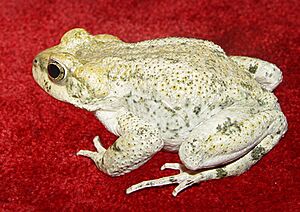Iranian earless toad facts for kids
Quick facts for kids Iranian earless toad |
|
|---|---|
 |
|
| Conservation status | |
| Scientific classification |
The Iranian earless toad, also known as Bufotes surdus, is a special kind of toad. People also call it the Iranian toad, Pakistan toad, or Luristan toad. It belongs to the Bufonidae family, which includes many types of toads.
You can find this toad mainly in southern Iran and western Pakistan. There has also been one sighting in eastern Iraq.
Contents
What Does It Look Like?
The Iranian earless toad is a medium-small toad. Adult toads are usually about 4 to 6 centimeters (1.6 to 2.4 inches) long from their snout to their rear end.
One very interesting thing about this toad is that it seems to have no ears! Most toads have a visible eardrum, called a tympanum. But the Iranian earless toad either has no tympanum, or it's very tiny and hidden under its skin. This is why it's called the "earless toad."
These toads usually have dull, plain colors. Sometimes, they might have faint greenish marks, especially on their legs. Occasionally, you might see small, green, ring-shaped spots on their skin.
Where Does It Live?
The Iranian earless toad lives in oases and around water pools in areas where people use water to grow crops. You can find them from sea level up to about 2,250 meters (7,380 feet) high.
Life Cycle and Reproduction
These toads breed during the monsoon season. Monsoons are times of heavy rain. During this time, male toads gather in temporary pools of water. The female toads lay their eggs around plants in these ponds.
When the dry season comes, these toads look for damp places to hide. They might go under stones or deep within plants to stay cool and moist.
Conservation Status
The Iranian earless toad can be quite common in some places. However, we don't know a lot about its daily life. Sometimes, young Iranian earless toads have been mistaken for other types of toads.
This toad faces some dangers. One big threat is the way farming is changing. When farms use more chemicals or expand too much, it can harm the toad's home. Long periods without rain, called droughts, can also make their numbers go down in certain areas. Luckily, some groups of these toads live in protected areas, which helps keep them safe.


